Performance evaluation of cognitive multi-hop networks to assist building system
ABSTRACT
In recent years, cognitive relay networks (CRNs) have emerged as a fantastic trend in
research. It supports the establishment of a new communication network by spectrumsharing technique. However, most papers focus on studying the performance of the dual-hop
scheme. This paper evaluates the proposed multi-hop model by giving the closed-form multihop network outage (OP). Simulation verifies our derivation and discovers the impact of
several related factors on the secondary outage probability. We also highlight the end-to-end
secondary multi-hop network by directly building the map to assist designers and operators
on a network.
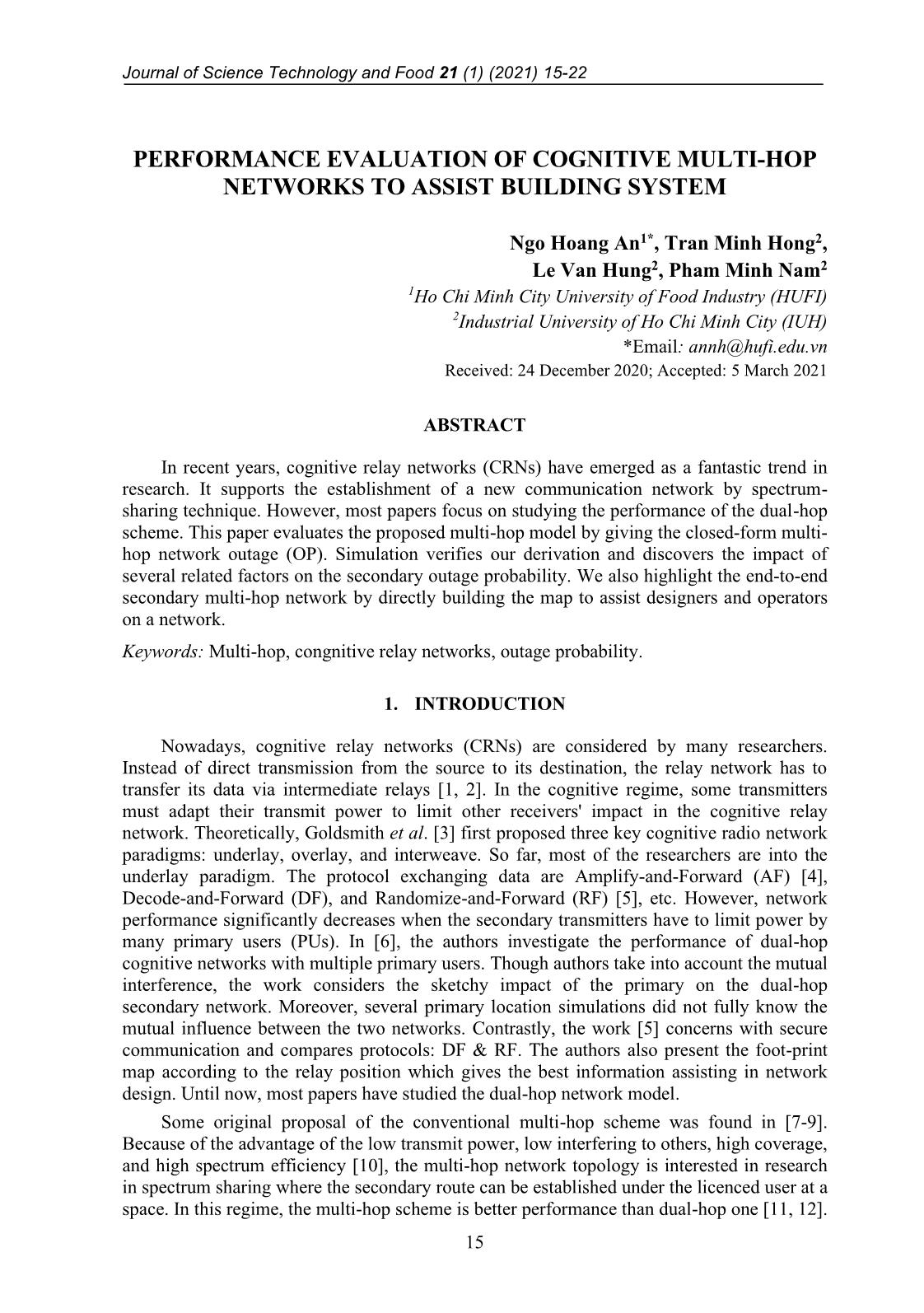
Trang 1
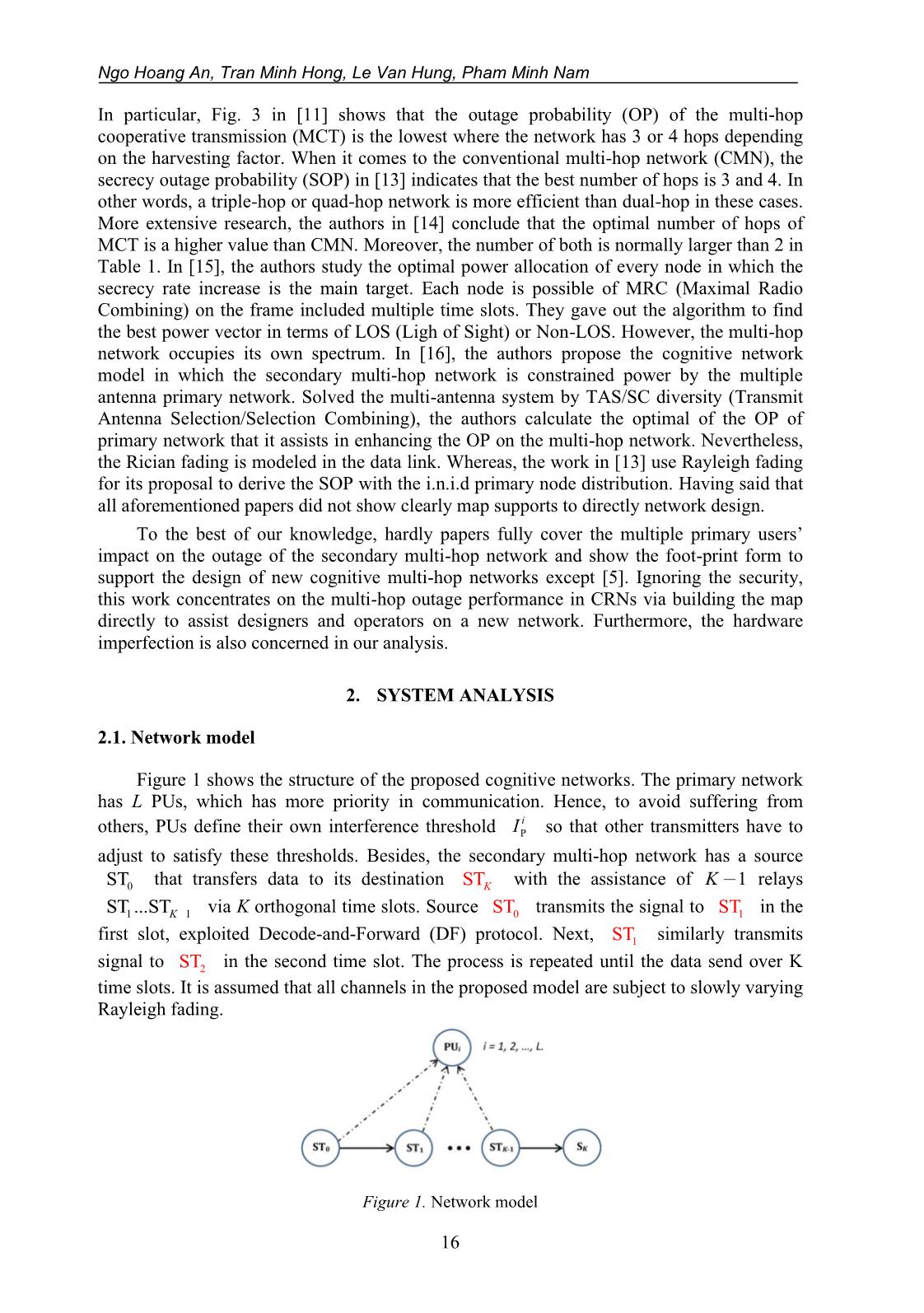
Trang 2
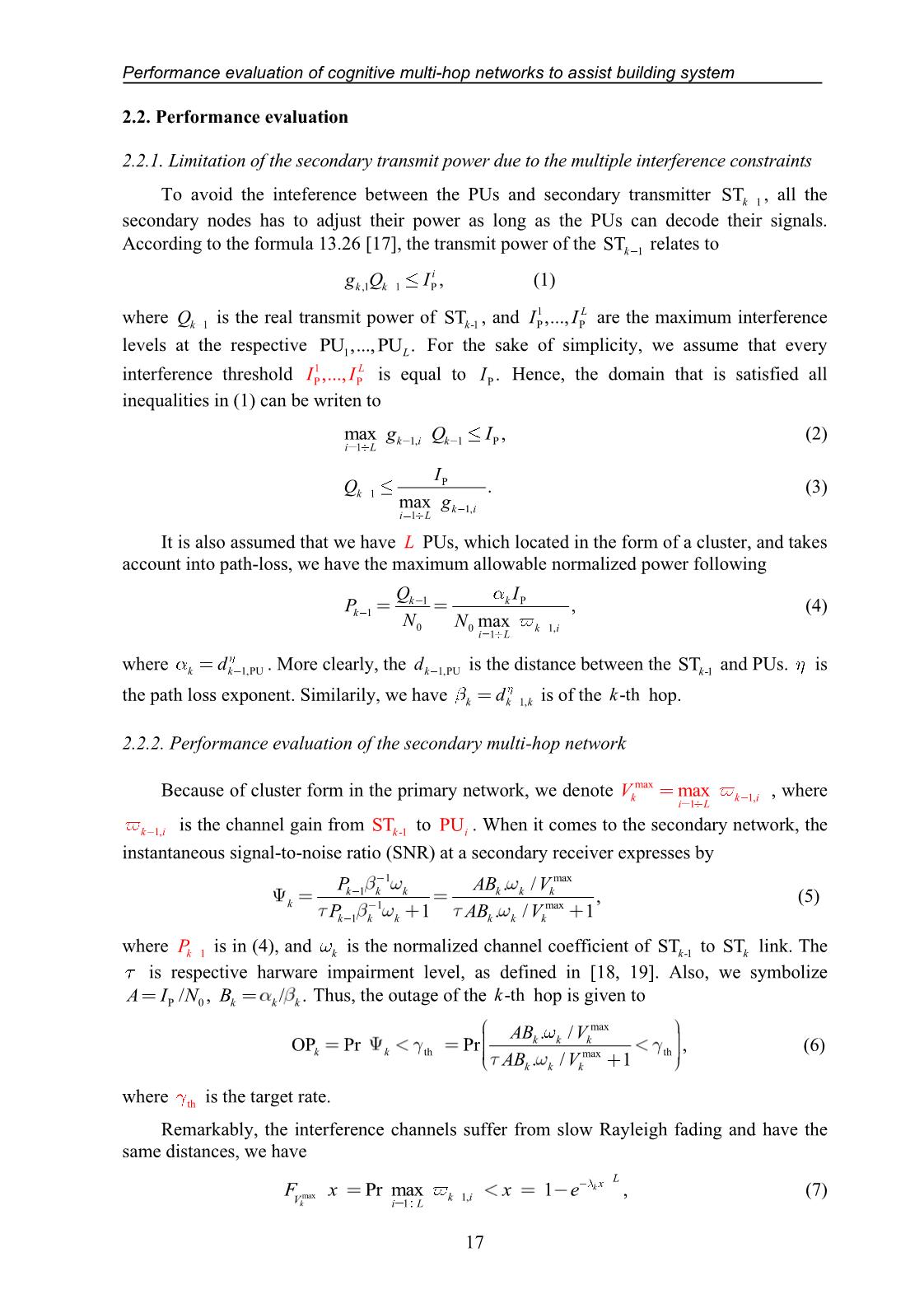
Trang 3
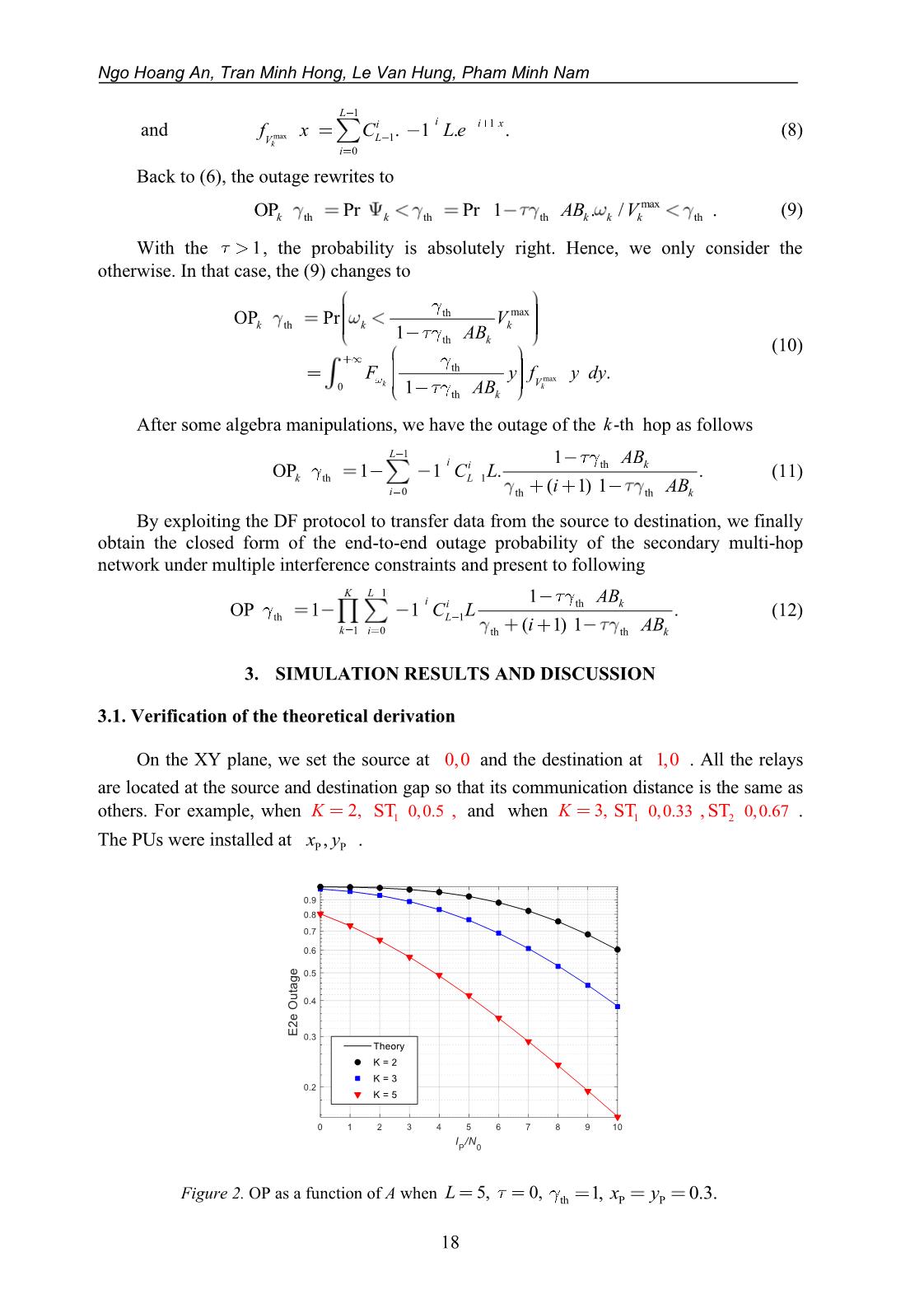
Trang 4
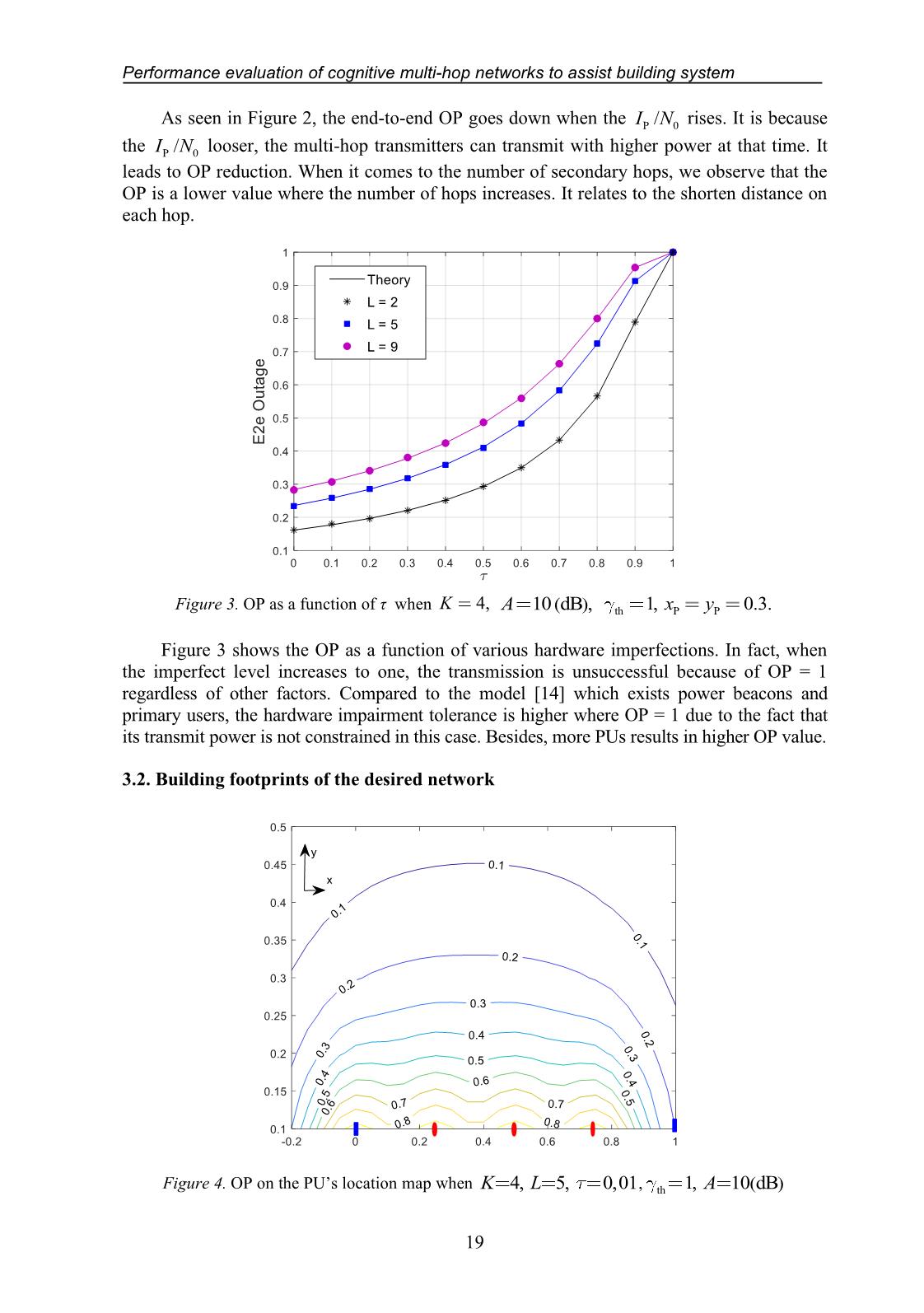
Trang 5
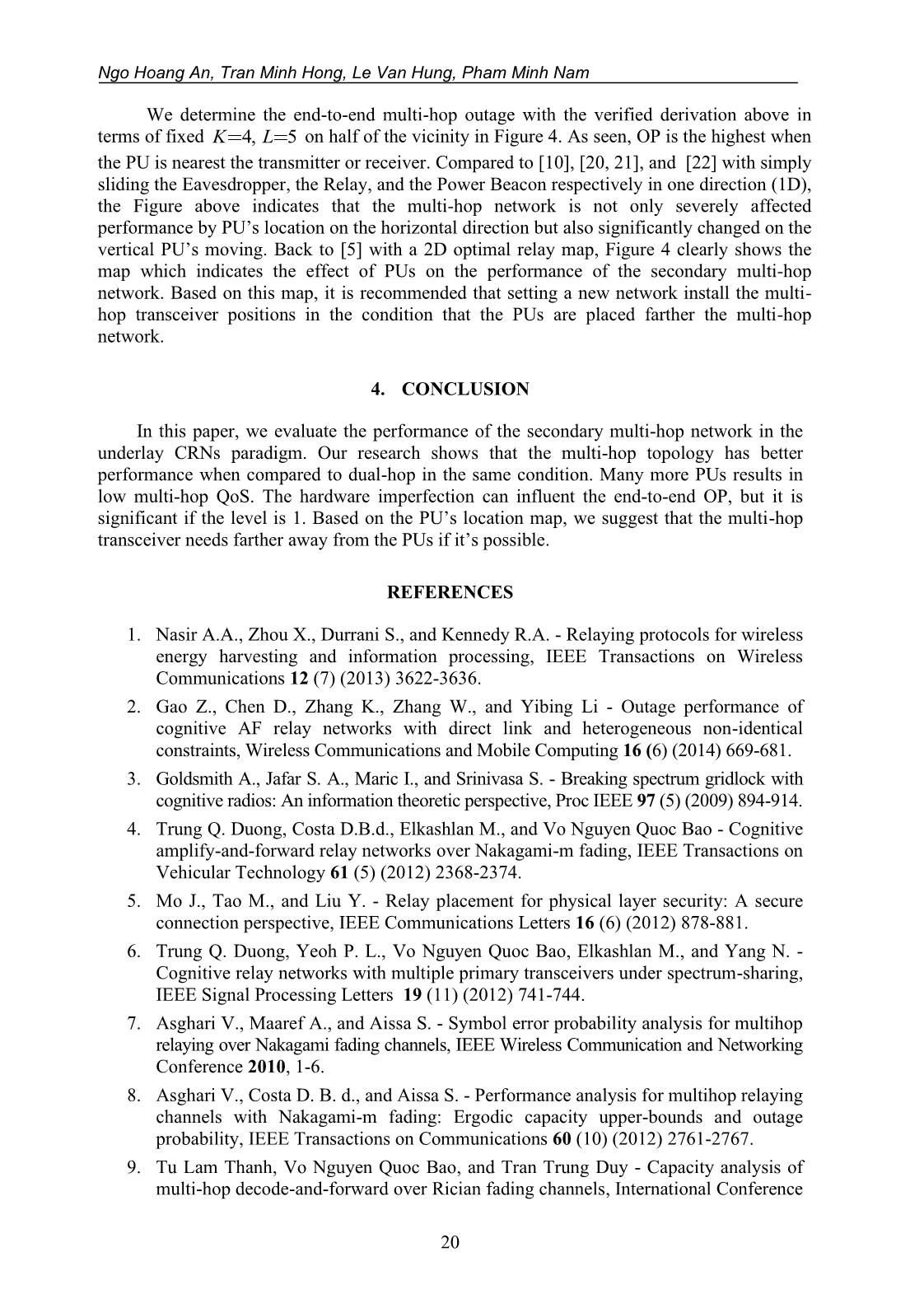
Trang 6
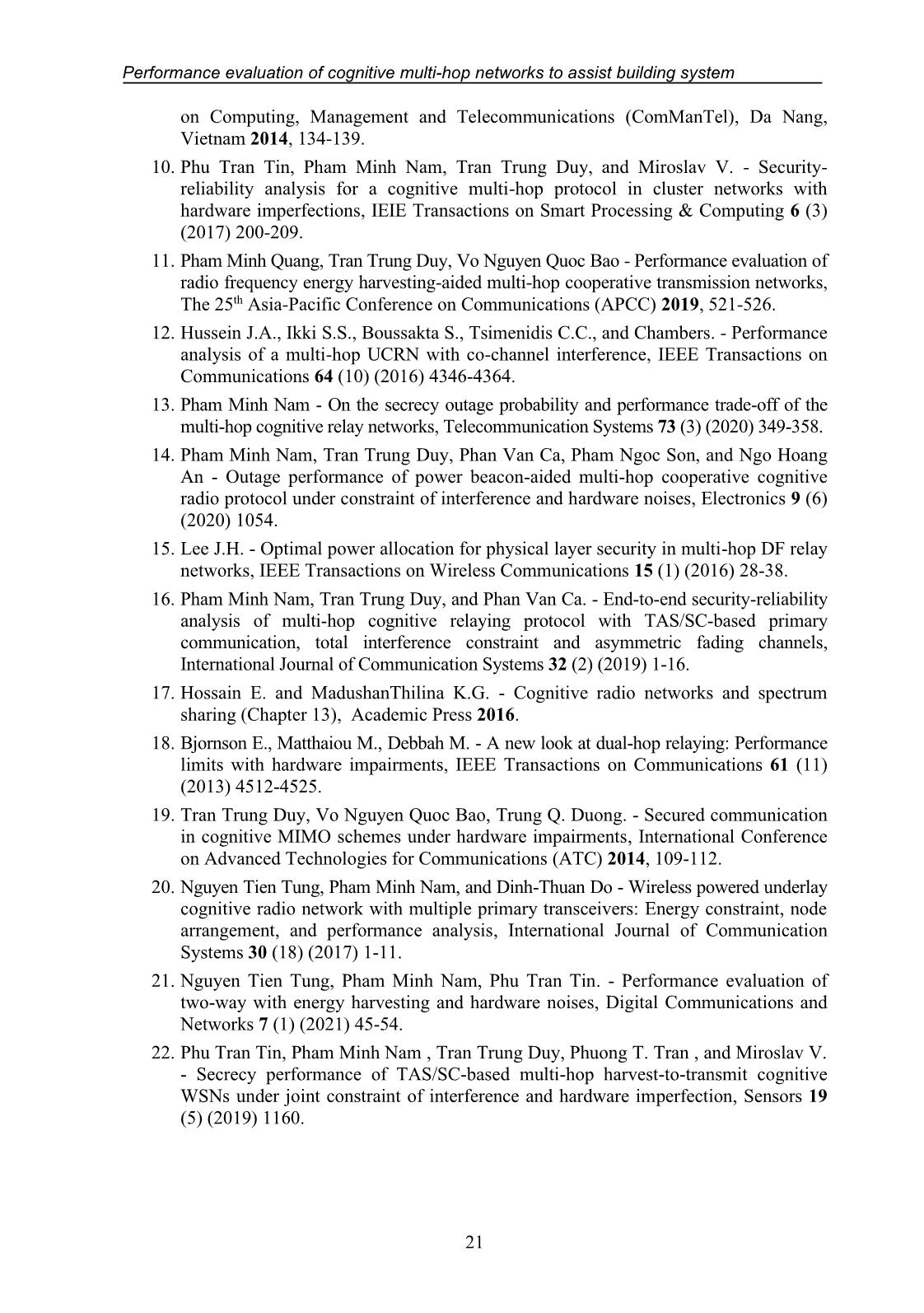
Trang 7
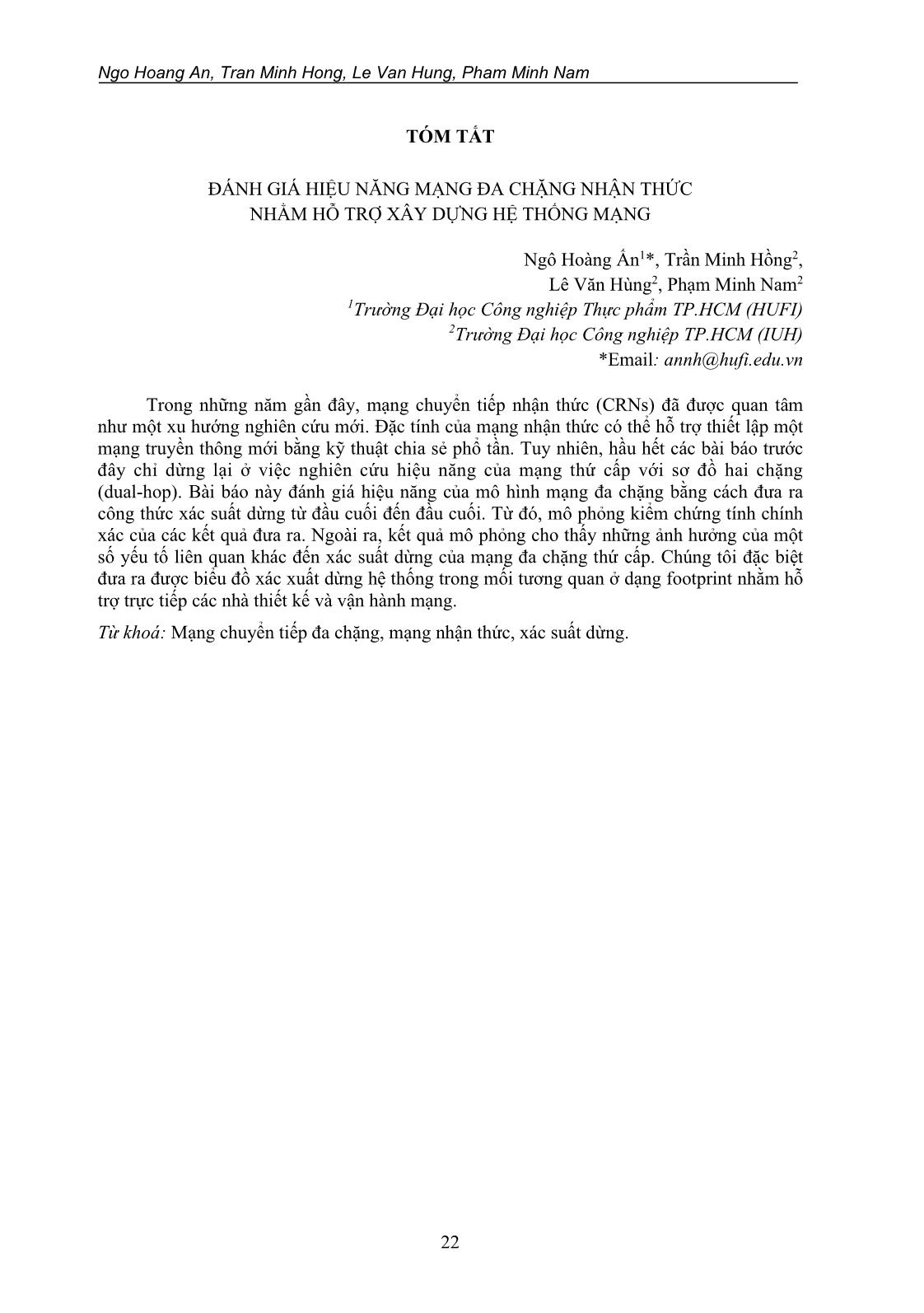
Trang 8
Bạn đang xem tài liệu "Performance evaluation of cognitive multi-hop networks to assist building system", để tải tài liệu gốc về máy hãy click vào nút Download ở trên
Tóm tắt nội dung tài liệu: Performance evaluation of cognitive multi-hop networks to assist building system
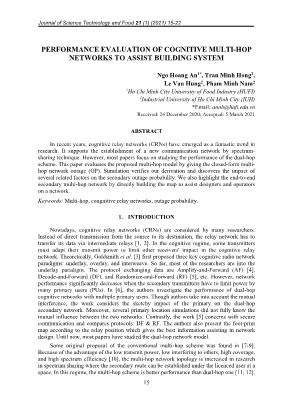
ncrease is the main target. Each node is possible of MRC (Maximal Radio Combining) on the frame included multiple time slots. They gave out the algorithm to find the best power vector in terms of LOS (Ligh of Sight) or Non-LOS. However, the multi-hop network occupies its own spectrum. In [16], the authors propose the cognitive network model in which the secondary multi-hop network is constrained power by the multiple antenna primary network. Solved the multi-antenna system by TAS/SC diversity (Transmit Antenna Selection/Selection Combining), the authors calculate the optimal of the OP of primary network that it assists in enhancing the OP on the multi-hop network. Nevertheless, the Rician fading is modeled in the data link. Whereas, the work in [13] use Rayleigh fading for its proposal to derive the SOP with the i.n.i.d primary node distribution. Having said that all aforementioned papers did not show clearly map supports to directly network design. To the best of our knowledge, hardly papers fully cover the multiple primary users’ impact on the outage of the secondary multi-hop network and show the foot-print form to support the design of new cognitive multi-hop networks except [5]. Ignoring the security, this work concentrates on the multi-hop outage performance in CRNs via building the map directly to assist designers and operators on a new network. Furthermore, the hardware imperfection is also concerned in our analysis. 2. SYSTEM ANALYSIS 2.1. Network model Figure 1 shows the structure of the proposed cognitive networks. The primary network has L PUs, which has more priority in communication. Hence, to avoid suffering from others, PUs define their own interference threshold P iI so that other transmitters have to adjust to satisfy these thresholds. Besides, the secondary multi-hop network has a source 0ST that transfers data to its destination STK with the assistance of 1K relays 1 1ST ...STK via K orthogonal time slots. Source 0ST transmits the signal to 1ST in the first slot, exploited Decode-and-Forward (DF) protocol. Next, 1ST similarly transmits signal to 2ST in the second time slot. The process is repeated until the data send over K time slots. It is assumed that all channels in the proposed model are subject to slowly varying Rayleigh fading. Figure 1. Network model Performance evaluation of cognitive multi-hop networks to assist building system 17 2.2. Performance evaluation 2.2.1. Limitation of the secondary transmit power due to the multiple interference constraints To avoid the inteference between the PUs and secondary transmitter 1STk , all the secondary nodes has to adjust their power as long as the PUs can decode their signals. According to the formula 13.26 [17], the transmit power of the 1STk relates to ,1 1 P , i k kg Q I (1) where 1kQ is the real transmit power of -1STk , and 1 P P,..., LI I are the maximum interference levels at the respective 1PU ,...,PU .L For the sake of simplicity, we assume that every interference threshold 1P P,..., LI I is equal to P .I Hence, the domain that is satisfied all inequalities in (1) can be writen to 1, 1 P 1 max ,k i k i L g Q I (2) P 1 1, 1 . max k k i i L I Q g (3) It is also assumed that we have L PUs, which located in the form of a cluster, and takes account into path-loss, we have the maximum allowable normalized power following 1 P 1 0 0 1, 1 , max k k k k i i L Q I P N N (4) where 1,PUk kd . More clearly, the 1,PUkd is the distance between the -1STk and PUs. is the path loss exponent. Similarily, we have 1,k k kd is of the -thk hop. 2.2.2. Performance evaluation of the secondary multi-hop network Because of cluster form in the primary network, we denote max 1, 1 maxk k i i L V , where 1,k i is the channel gain from -1STk to PUi . When it comes to the secondary network, the instantaneous signal-to-noise ratio (SNR) at a secondary receiver expresses by 1 max 1 1 max 1 . / , 1 . / 1 k k k k k k k k k k k k k P AB V P AB V (5) where 1kP is in (4), and k is the normalized channel coefficient of -1STk to STk link. The is respective harware impairment level, as defined in [18, 19]. Also, we symbolize P 0/A I N , / .k k kB Thus, the outage of the -thk hop is given to max th thmax . / OP Pr Pr , . / 1 k k k k k k k k AB V AB V (6) where th is the target rate. Remarkably, the interference channels suffer from slow Rayleigh fading and have the same distances, we have max 1, 1 P maxr 1 ,k k k i iV L L x F x x e (7) Ngo Hoang An, Tran Minh Hong, Le Van Hung, Pham Minh Nam 18 and max 1 1 1 0 . .. 1 k L ii L i i x V Cf x L e (8) Back to (6), the outage rewrites to max th th th thOP Pr Pr 1 . / .k k k k kAB V (9) With the 1 , the probability is absolutely right. Hence, we only consider the otherwise. In that case, the (9) changes to max maxth th th th th 0 O P 1 . P r 1k kV k k k k k F f V AB y y AB dy (10) After some algebra manipulations, we have the outage of the -thk hop as follows 1 th th 1 0 th th 1 . . 1) 1 OP 1 ( 1 L i ki k L i k AB C A L i B (11) By exploiting the DF protocol to transfer data from the source to destination, we finally obtain the closed form of the end-to-end outage probability of the secondary multi-hop network under multiple interference constraints and present to following 1 th th 1 1 0 th th 1 OP 1 1 ( 1 . 1) LK i ki L k i k L AB C i AB (12) 3. SIMULATION RESULTS AND DISCUSSION 3.1. Verification of the theoretical derivation On the XY plane, we set the source at 0,0 and the destination at 1,0 . All the relays are located at the source and destination gap so that its communication distance is the same as others. For example, when 2,K 1 0,0.5ST , and when 3,K 1 20,0.33 0,0.67ST , ST . The PUs were installed at P P,x y . Figure 2. OP as a function of A when 5,L 0, th 1, P P 0.3.x y Performance evaluation of cognitive multi-hop networks to assist building system 19 As seen in Figure 2, the end-to-end OP goes down when the P 0/I N rises. It is because the P 0/I N looser, the multi-hop transmitters can transmit with higher power at that time. It leads to OP reduction. When it comes to the number of secondary hops, we observe that the OP is a lower value where the number of hops increases. It relates to the shorten distance on each hop. Figure 3. OP as a function of τ when 4,K ( )10 dB ,A th 1, P P 0.3.x y Figure 3 shows the OP as a function of various hardware imperfections. In fact, when the imperfect level increases to one, the transmission is unsuccessful because of OP = 1 regardless of other factors. Compared to the model [14] which exists power beacons and primary users, the hardware impairment tolerance is higher where OP = 1 due to the fact that its transmit power is not constrained in this case. Besides, more PUs results in higher OP value. 3.2. Building footprints of the desired network Figure 4. OP on the PU’s location map when 4,K 5,L 0,01, th 1, ( )10 dBA Ngo Hoang An, Tran Minh Hong, Le Van Hung, Pham Minh Nam 20 We determine the end-to-end multi-hop outage with the verified derivation above in terms of fixed 4,K 5L on half of the vicinity in Figure 4. As seen, OP is the highest when the PU is nearest the transmitter or receiver. Compared to [10], [20, 21], and [22] with simply sliding the Eavesdropper, the Relay, and the Power Beacon respectively in one direction (1D), the Figure above indicates that the multi-hop network is not only severely affected performance by PU’s location on the horizontal direction but also significantly changed on the vertical PU’s moving. Back to [5] with a 2D optimal relay map, Figure 4 clearly shows the map which indicates the effect of PUs on the performance of the secondary multi-hop network. Based on this map, it is recommended that setting a new network install the multi- hop transceiver positions in the condition that the PUs are placed farther the multi-hop network. 4. CONCLUSION In this paper, we evaluate the performance of the secondary multi-hop network in the underlay CRNs paradigm. Our research shows that the multi-hop topology has better performance when compared to dual-hop in the same condition. Many more PUs results in low multi-hop QoS. The hardware imperfection can influent the end-to-end OP, but it is significant if the level is 1. Based on the PU’s location map, we suggest that the multi-hop transceiver needs farther away from the PUs if it’s possible. REFERENCES 1. Nasir A.A., Zhou X., Durrani S., and Kennedy R.A. - Relaying protocols for wireless energy harvesting and information processing, IEEE Transactions on Wireless Communications 12 (7) (2013) 3622-3636. 2. Gao Z., Chen D., Zhang K., Zhang W., and Yibing Li - Outage performance of cognitive AF relay networks with direct link and heterogeneous non-identical constraints, Wireless Communications and Mobile Computing 16 (6) (2014) 669-681. 3. Goldsmith A., Jafar S. A., Maric I., and Srinivasa S. - Breaking spectrum gridlock with cognitive radios: An information theoretic perspective, Proc IEEE 97 (5) (2009) 894-914. 4. Trung Q. Duong, Costa D.B.d., Elkashlan M., and Vo Nguyen Quoc Bao - Cognitive amplify-and-forward relay networks over Nakagami-m fading, IEEE Transactions on Vehicular Technology 61 (5) (2012) 2368-2374. 5. Mo J., Tao M., and Liu Y. - Relay placement for physical layer security: A secure connection perspective, IEEE Communications Letters 16 (6) (2012) 878-881. 6. Trung Q. Duong, Yeoh P. L., Vo Nguyen Quoc Bao, Elkashlan M., and Yang N. - Cognitive relay networks with multiple primary transceivers under spectrum-sharing, IEEE Signal Processing Letters 19 (11) (2012) 741-744. 7. Asghari V., Maaref A., and Aissa S. - Symbol error probability analysis for multihop relaying over Nakagami fading channels, IEEE Wireless Communication and Networking Conference 2010, 1-6. 8. Asghari V., Costa D. B. d., and Aissa S. - Performance analysis for multihop relaying channels with Nakagami-m fading: Ergodic capacity upper-bounds and outage probability, IEEE Transactions on Communications 60 (10) (2012) 2761-2767. 9. Tu Lam Thanh, Vo Nguyen Quoc Bao, and Tran Trung Duy - Capacity analysis of multi-hop decode-and-forward over Rician fading channels, International Conference Performance evaluation of cognitive multi-hop networks to assist building system 21 on Computing, Management and Telecommunications (ComManTel), Da Nang, Vietnam 2014, 134-139. 10. Phu Tran Tin, Pham Minh Nam, Tran Trung Duy, and Miroslav V. - Security- reliability analysis for a cognitive multi-hop protocol in cluster networks with hardware imperfections, IEIE Transactions on Smart Processing & Computing 6 (3) (2017) 200-209. 11. Pham Minh Quang, Tran Trung Duy, Vo Nguyen Quoc Bao - Performance evaluation of radio frequency energy harvesting-aided multi-hop cooperative transmission networks, The 25th Asia-Pacific Conference on Communications (APCC) 2019, 521-526. 12. Hussein J.A., Ikki S.S., Boussakta S., Tsimenidis C.C., and Chambers. - Performance analysis of a multi-hop UCRN with co-channel interference, IEEE Transactions on Communications 64 (10) (2016) 4346-4364. 13. Pham Minh Nam - On the secrecy outage probability and performance trade-off of the multi-hop cognitive relay networks, Telecommunication Systems 73 (3) (2020) 349-358. 14. Pham Minh Nam, Tran Trung Duy, Phan Van Ca, Pham Ngoc Son, and Ngo Hoang An - Outage performance of power beacon-aided multi-hop cooperative cognitive radio protocol under constraint of interference and hardware noises, Electronics 9 (6) (2020) 1054. 15. Lee J.H. - Optimal power allocation for physical layer security in multi-hop DF relay networks, IEEE Transactions on Wireless Communications 15 (1) (2016) 28-38. 16. Pham Minh Nam, Tran Trung Duy, and Phan Van Ca. - End‐to‐end security‐reliability analysis of multi‐hop cognitive relaying protocol with TAS/SC‐based primary communication, total interference constraint and asymmetric fading channels, International Journal of Communication Systems 32 (2) (2019) 1-16. 17. Hossain E. and MadushanThilina K.G. - Cognitive radio networks and spectrum sharing (Chapter 13), Academic Press 2016. 18. Bjornson E., Matthaiou M., Debbah M. - A new look at dual-hop relaying: Performance limits with hardware impairments, IEEE Transactions on Communications 61 (11) (2013) 4512-4525. 19. Tran Trung Duy, Vo Nguyen Quoc Bao, Trung Q. Duong. - Secured communication in cognitive MIMO schemes under hardware impairments, International Conference on Advanced Technologies for Communications (ATC) 2014, 109-112. 20. Nguyen Tien Tung, Pham Minh Nam, and Dinh-Thuan Do - Wireless powered underlay cognitive radio network with multiple primary transceivers: Energy constraint, node arrangement, and performance analysis, International Journal of Communication Systems 30 (18) (2017) 1-11. 21. Nguyen Tien Tung, Pham Minh Nam, Phu Tran Tin. - Performance evaluation of two-way with energy harvesting and hardware noises, Digital Communications and Networks 7 (1) (2021) 45-54. 22. Phu Tran Tin, Pham Minh Nam , Tran Trung Duy, Phuong T. Tran , and Miroslav V. - Secrecy performance of TAS/SC-based multi-hop harvest-to-transmit cognitive WSNs under joint constraint of interference and hardware imperfection, Sensors 19 (5) (2019) 1160. Ngo Hoang An, Tran Minh Hong, Le Van Hung, Pham Minh Nam 22 TÓM TẮT ĐÁNH GIÁ HIỆU NĂNG MẠNG ĐA CHẶNG NHẬN THỨC NHẰM HỖ TRỢ XÂY DỰNG HỆ THỐNG MẠNG Ngô Hoàng Ấn1*, Trần Minh Hồng2, Lê Văn Hùng2, Phạm Minh Nam2 1Trường Đại học Công nghiệp Thực phẩm TP.HCM (HUFI) 2Trường Đại học Công nghiệp TP.HCM (IUH) *Email: annh@hufi.edu.vn Trong những năm gần đây, mạng chuyển tiếp nhận thức (CRNs) đã được quan tâm như một xu hướng nghiên cứu mới. Đặc tính của mạng nhận thức có thể hỗ trợ thiết lập một mạng truyền thông mới bằng kỹ thuật chia sẻ phổ tần. Tuy nhiên, hầu hết các bài báo trước đây chỉ dừng lại ở việc nghiên cứu hiệu năng của mạng thứ cấp với sơ đồ hai chặng (dual-hop). Bài báo này đánh giá hiệu năng của mô hình mạng đa chặng bằng cách đưa ra công thức xác suất dừng từ đầu cuối đến đầu cuối. Từ đó, mô phỏng kiểm chứng tính chính xác của các kết quả đưa ra. Ngoài ra, kết quả mô phỏng cho thấy những ảnh hưởng của một số yếu tố liên quan khác đến xác suất dừng của mạng đa chặng thứ cấp. Chúng tôi đặc biệt đưa ra được biểu đồ xác xuất dừng hệ thống trong mối tương quan ở dạng footprint nhằm hỗ trợ trực tiếp các nhà thiết kế và vận hành mạng. Từ khoá: Mạng chuyển tiếp đa chặng, mạng nhận thức, xác suất dừng.
File đính kèm:
 performance_evaluation_of_cognitive_multi_hop_networks_to_as.pdf
performance_evaluation_of_cognitive_multi_hop_networks_to_as.pdf

